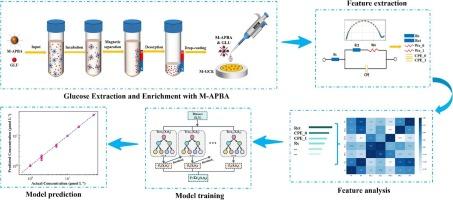3-氨基苯基硼酸修饰磁性纳米颗粒辅助交流阻抗法对实际样品中葡萄糖的特异性识别,并通过GridSearch-XGBoost进行预测分析
IF 4.9
2区 化学
Q1 CHEMISTRY, ANALYTICAL
引用次数: 0
摘要
提出了一种基于3-氨基苯基硼酸修饰磁性纳米颗粒(M-APBA)的电化学阻抗检测方法,并利用机器学习模型实现了复杂生物样品中葡萄糖的高灵敏度和高精度检测。利用合成的M-APBA纳米颗粒与葡萄糖的特异性结合亲和性,显著提高了检测灵敏度和抗干扰能力。实验结果表明,葡萄糖浓度在1 ~ 50 μmol L−1范围内具有良好的线性响应,检出限低至0.71 μmol L−1。采用Randles等效电路模型提取了葡萄糖的多维阻抗谱特征,并结合网格搜索优化的XGBoost模型,显著提高了实际样品中葡萄糖浓度的预测精度。模型的R2值为0.9997,平均绝对误差(MAE)和均方根误差(RMSE)分别降至0.1068和0.2321。与传统的单特征拟合方法(Rct值)相比,本文提出的多特征融合方法在复杂生物样品中具有更高的检测精度和稳定性。此外,对实际样品的测量表明,M-APBA纳米粒子修饰电极在复杂环境下仍保持了优异的检测性能,具有高重复性和强抗干扰能力。本研究提出了一种非酶促葡萄糖检测策略,通过将m - apba修饰的磁性纳米颗粒与基于机器学习的阻抗分析框架相结合,为无创、实时葡萄糖监测提供了一种新的解决方案,并在便携式、低成本的可穿戴检测设备中展示了巨大的应用潜力。本文章由计算机程序翻译,如有差异,请以英文原文为准。

The specific recognition of glucose in real samples by AC-impedance method assisted with 3-aminophenylboronic acid-modified magnetic nanoparticles and predictive analysis via GridSearch-XGBoost
An electrochemical impedance detection method based on 3-aminophenylboronic acid-modified magnetic nanoparticles (M-APBA) is proposed, with machine learning models employed to facilitate high-sensitivity and high-accuracy glucose detection in complex biological samples. By leveraging the specific binding affinity between synthesized M-APBA nanoparticles and glucose, detection sensitivity and anti-interference capability were significantly enhanced. Experimental results demonstrated a well-defined linear response for glucose concentrations ranging from 1 to 50 μmol L−1, with a detection limit as low as 0.71 μmol L−1. Multidimensional impedance spectral features were extracted using the Randles equivalent circuit model, and the prediction accuracy of glucose concentration in real sample was significantly improved by incorporating an XGBoost model optimized via grid search method. The model achieved an R2 value of 0.9997, with mean absolute error (MAE) and root mean square error (RMSE) reduced to 0.1068 and 0.2321, respectively. Compared with traditional single-feature fitting methods (the Rct value), the proposed multi-feature fusion approach demonstrated superior detection accuracy and stability in complex biological samples. Furthermore, measurements conducted on real samples revealed that M-APBA nanoparticle-modified electrodes maintained excellent detection performance in complex environments, exhibiting high repeatability and strong anti-interference capability. This study proposes a non-enzymatic glucose detection strategy by integrating M-APBA-modified magnetic nanoparticles with a machine learning-based impedance analysis framework, offering a novel solution for non-invasive, real-time glucose monitoring and demonstrating great potential for application in portable, low-cost wearable detection devices.
求助全文
通过发布文献求助,成功后即可免费获取论文全文。
去求助
来源期刊

Microchemical Journal
化学-分析化学
CiteScore
8.70
自引率
8.30%
发文量
1131
审稿时长
1.9 months
期刊介绍:
The Microchemical Journal is a peer reviewed journal devoted to all aspects and phases of analytical chemistry and chemical analysis. The Microchemical Journal publishes articles which are at the forefront of modern analytical chemistry and cover innovations in the techniques to the finest possible limits. This includes fundamental aspects, instrumentation, new developments, innovative and novel methods and applications including environmental and clinical field.
Traditional classical analytical methods such as spectrophotometry and titrimetry as well as established instrumentation methods such as flame and graphite furnace atomic absorption spectrometry, gas chromatography, and modified glassy or carbon electrode electrochemical methods will be considered, provided they show significant improvements and novelty compared to the established methods.
 求助内容:
求助内容: 应助结果提醒方式:
应助结果提醒方式:


